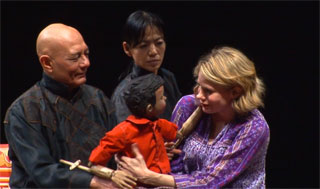 Award-winning playwright Sarah Ruhl’s latest work, The Oldest Boy, tells the story of an American boy’s selection as a tulku, a reincarnated lama of the Tibetan Buddhist tradition. When monks arrive and ask to take the child away for training in India, his American mother (Tony Award nominee Celia Keenan-Bolger) and Tibetan father (James Yaegashi) must make the most difficult decision of their lives. Directed by Rebecca Taichman, The Oldest Boy is running at Lincoln Center in New York City until December 28, 2014. The Lincoln Center Theater Review posed five questions to its writer, Sarah Ruhl:
Award-winning playwright Sarah Ruhl’s latest work, The Oldest Boy, tells the story of an American boy’s selection as a tulku, a reincarnated lama of the Tibetan Buddhist tradition. When monks arrive and ask to take the child away for training in India, his American mother (Tony Award nominee Celia Keenan-Bolger) and Tibetan father (James Yaegashi) must make the most difficult decision of their lives. Directed by Rebecca Taichman, The Oldest Boy is running at Lincoln Center in New York City until December 28, 2014. The Lincoln Center Theater Review posed five questions to its writer, Sarah Ruhl:
1. How did a Catholic white girl from Illinois come to write about Tibetan Buddhism?
I have three children. My first daughter, Anna, was born shortly before I did The Clean House at Lincoln Center. For eight years, we’ve had a wonderful babysitter named Yangzom. She is from Queens, by way of India, by way of Tibet. Because I often work from home, usually writing in the dining room, Yangzom and I have gotten to know each other very well. We have shared the strange intimacy of sitting in a room together while she gave a bottle to one of my newborn twins while I breast-fed the other baby. We have administered nebulizers and Tylenol to sick children together, celebrated birthdays together, and rejoiced in first steps together.
Over the years, she has told me many stories—about life in exile in India, and what it was like to escape Tibet with the Chinese army in pursuit, her twelve-day-old daughter strapped on her back as she navigated the Himalayas. When her mother came from Nepal for her first visit to the United States, she visited our home. Yangzom knelt at her mother’s feet, as was the custom, and her mother smiled at my children, and silently prayed, for hours. I was raised in a small town in Illinois—and the world was getting both bigger and smaller. When Yangzom lived in India she sent her children to boarding school in Darjeeling, the same English boarding school, oddly, that my Thai father-in-law attended. The world continued to get smaller, and I, an ambivalent Catholic from Illinois, learned more and more about Tibetan Buddhism and the beauty and resilience of the Tibetan culture. This play is dedicated to Yangzom, because a story that she told me brought it about.
Three years ago, she told me a story about Tibetan friends of hers in Boston who had a successful restaurant. One day, monks from India arrived to tell the family that their son was a reincarnated lama, or high teacher. I said, “Well, what did they do?” Yangzom said, “They closed the restaurant and moved to India to educate the child at a monastery.” Having three kids myself, I found it incomprehensible to let go of a child with any grace, even if it was for his or her own spiritual development. I wanted to write about the subject, but I felt that if there was to be dramatic conflict there had better be a white woman, or a woman not culturally raised to be a Buddhist, in the play. I was interested in exploring the dynamic between the “attachment parenting” phenomena in certain mothering circles in the United States, and a vague interest that the same set of people might have in Buddhism, which emphasizes nonattachment.
Every day as I wave to my children when I drop them off at school, or let one of them have a new experience—like crossing the street without holding my hand—I experience the struggle between love and nonattachment. It is hard to bear—the extreme love of one’s child and the thought that, ultimately, the child belongs to the world. There is this horrible design flaw—children are supposed to grow up and away from you, and one of you will die first.
Motherhood is a predicament. How to live fully inside it with any grace? And how to write about it?
2. Why puppets?
As I considered writing a play about a child who was a reincarnated spiritual master, I wondered how I would cast that role with a three-year-old who could memorize lines, project, and evince the spiritual authority of a 70-year-old lama. This seemed an almost impossible task. Since three-year-olds aren’t very reliable, I decided to use a puppet. I’ve always wanted to work with puppets, and I felt that the puppet would be the clearest way to see both the child and the child’s previous life at the same time. I wanted there to be little or no doubt in the play that the child was in fact a reincarnation, so that the characters in the play, when presented with the news, could be more concerned with the question of “Now what?” rather than, to my mind, the less interesting question of “Is he or isn’t he?”
The metaphor of the puppet and the puppeteer is meant to connect the child, or the body, with the older spirit that animates the child. I was not interested in the cliché of the puppet as an object to be manipulated. Eric Bass, a puppet-maker, says it better than I can in his wonderful essay “The Myths of Puppet Theater”:
There are two myths about puppet theater that need to be exploded. The first of them . . . is the myth that the puppeteer controls the puppet. This myth is, of course, supported by numerous catch phrases in our language and culture: He played him like a puppet. Puppet government. All suggest that the puppeteer makes the puppet do whatever he or she wants. Although some puppeteers do try to impose their will on the objects of their art, most know that this is a disservice to both the art and the object. Our job, our art, is to bring the puppet to life. To impose control over the object is, in both spirit and practice, the opposite of this.
As puppeteers, it is, surprisingly, not our job to impose our intent on the puppet. It is our job to discover what the puppet can do and what it seems to want to do. It has propensities. We want to find out what they are, and support them. We are, in this sense, less like tyrants, and more like nurses to these objects. . . . They seem to have destinies. We want to help them arrive at those destinies . . . . It requires from us a generosity. If we try to dominate them, we will take from them the life we are trying to give them.
 3. Have there ever been Western reincarnations of Tibetan lamas?
3. Have there ever been Western reincarnations of Tibetan lamas?
While this play is utterly a fiction, there are a handful of Tibetan lamas who have been reincarnated in the West, sometimes to white parents, or to intercultural parents. I had the good fortune to meet with one such tulku when he was all grown up. His mother was American and his father was French, and both were Tibetan Buddhists. He was recognized as a reincarnate lama at the age of three, and enthroned in a monastery in India. I asked him how his mother was able to make such a decision. He said that she was very clear in her decision, because he himself, as a three-year-old, expressed a strong desire to go to the monastery. Much of her pain came from the cultural opprobrium of other French mothers who didn’t understand her decision.
As it becomes more and more difficult to openly practice Buddhism in Tibet because of the crackdown of the Chinese occupation, it becomes increasingly common for high teachers to choose reincarnations outside Tibet. Tibetan Buddhists believe that while all of us are reborn, high spiritual masters are reincarnated, which means that they get to choose their new life, and often they choose a context that will be most fruitful to them in continuing their life’s work.
I was first introduced to the concept of the tulku system, in which the student searches for the reincarnation of his former teacher, by the beautiful documentary The Unmistaken Child. I was so moved by the idea that a student could find a teacher again; that the student becomes the teacher, and the teacher becomes the student, lifetime after lifetime. I have been very lucky in my own life to have had extraordinary teachers. I was comforted by the idea that I might have known them before, and might know them again.
4. How is your life different from that of a Tibetan living in Tibet?
I am free to learn and study in my own language. I can leave my country and return. I have a passport. I am a citizen of my country. I can pray without going to jail. I am not asked to denounce my God or to walk on pictures of what I consider to be sacred. My house and my church have not been summarily destroyed by an occupying nation. I can own a picture of my spiritual or secular leader without going to jail. I can write a book about my life, or tell stories of the past to my children, and not go to jail.
If I went to jail, I could get a lawyer. I would not be held indefinitely for decades by Chinese officials. I would not have my arms and feet shackled while being suspended from the ceiling. I would not have an electric prod inserted into my vagina, along with nuns who have taken vows of chastity. I would not be doused with boiling water. I would not be urinated on by guards. I would not have bamboo splinters placed under my fingernails. I would be visited. I would be fed.
5. Given that your life is so very different from life in Tibet, what right have you to write Tibetan characters?
I ask myself that every day that we rehearse this play. I remind myself of what I have in common with an average mother or father living in Tibet: I love my children. I want the best for them. It hurts me when they are sick, or when I’m parted from them. I wonder what it’s like to die. I love my teachers. I miss my father. I wonder how it is that we are all connected, despite our tremendous differences.
There is a saying: The five world religions are like the five fingers of the hand, pointing to the same moon. And I wonder, along with my children, what is the moon?
Courtesy of Lincoln Center Theater Review